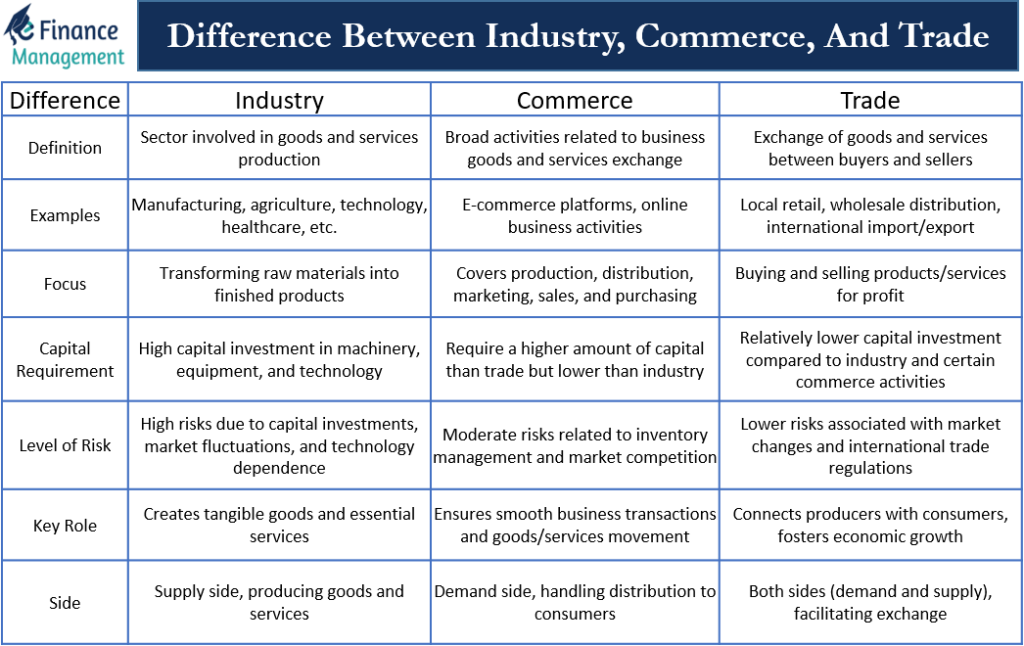In the dynamic landscape of economic activities, the terms “industry,” “commerce,” and “trade” are often used interchangeably. However, they represent distinct concepts that play crucial roles in shaping the business world. Understanding the differences between these terms is essential for gaining insights into the intricate workings of economies and the interconnectedness of various business activities.
In this exploration, we will learn about the disparities between industry, commerce, and trade, shedding light on their unique characteristics, functions, and contributions to the global economy. By comprehending their individual roles, we can appreciate how these components collectively form the backbone of business operations, driving innovation, exchange, and prosperity in the modern world.
Difference Between Industry, Commerce, And Trade
Definition
Industry: It refers to the sector of economic activity involved in the extraction, construction, or manufacturing of goods and services.
Commerce: It encompasses a broad range of activities related to the exchange of goods and services in the business world.
Trade: It involves the exchange of goods and services between buyers and sellers, either within a country or internationally.
Examples
Industry: Examples of industries include manufacturing (e.g., automobile, electronics), agriculture, technology, healthcare, finance, and more.
Commerce: E-commerce is a prime example of the commerce sector. It encompasses a broad range of activities involved in conducting business online. E-commerce platforms serve as digital marketplaces where buyers and sellers interact, offering a wide variety of products and services.
Trade: Types of trade include local retail, wholesale distribution, and international import/export.
Focus
Industry: Its primary focus is on transforming raw materials or inputs into finished products through various processes.
Commerce: It covers the entire process of conducting business, from production and distribution to marketing, sales, and purchasing.
Trade: It focuses on the buying and selling of products or services, often with the objective of making a profit.
Capital Requirement
Industry: Industries often require substantial capital investment in machinery, equipment, and technology to set up production facilities and maintain efficient operations.
Commerce: Commerce activities typically require a higher amount of capital than trade but a lower amount compared to industry to operate their activities.
Trade: Trade activities typically require relatively lower capital investment compared to industries or certain commerce operations.
Level of Risk
Industry: Riskier than commerce and trade. Industries face higher risks due to large capital investments, market fluctuations, and dependence on technology and market demand.
Commerce: Less risky than industry but involves higher risk than trade. Commerce faces risks related to inventory management, market competition, and changing consumer preferences.
Trade: Less risky than both industry and commerce. Trade risks are primarily associated with market changes, currency fluctuations, and international trade regulations.
Key Role
Industry: Industries are responsible for creating tangible goods and essential services that meet consumer demands.
Commerce: Commerce ensures the smooth functioning of business transactions and supports trade by facilitating the movement of goods and services.
Trade: Trade connects producers with consumers, enabling access to a wider range of products and services, and fosters economic growth by promoting the flow of goods and services in the market.
Side
Industry: The industry operates on the supply side of the product, producing goods and services.
Commerce: Commerce operates on the demand side of the product, handling distribution and ensuring goods reach consumers.
Trade: Trade operates on both sides (demand and supply) of the product, facilitating the exchange between producers and consumers.
Difference Between Industry, Commerce, And Trade (In Table)

Conclusion
Each component contributes uniquely to the economy, with different risk profiles and roles in facilitating economic growth and consumer access to goods and services. The industry operates in workshops or factories, commerce operates from production centers to distribution centers, and trade operates in the market where buyers and sellers interact. Each component plays a unique role in the economic landscape, involving different places of operation and contributing to the production, distribution, and exchange of goods and services.
RELATED POSTS
- International Business
- Types of International Business – Advantages and Disadvantages
- Competitive Advantage vs Comparative Advantage – All You Need to Know
- International Market – Lucrative But Challenging As Well
- International Trade Theory – All You Need to Know
- International Business Environment – All You Need to Know

